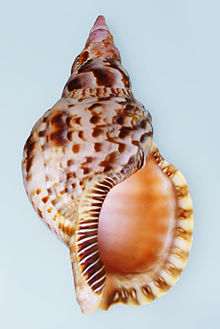Triton (gastropod)
| Triton Temporal range: Cretaceous - Recent |
|
|---|---|
 |
|
| Apertural view of a shell of Charonia variegata | |
| Scientific classification | |
| Kingdom: | Animalia |
| Phylum: | Mollusca |
| Class: | Gastropoda |
| (unranked): | clade Caenogastropoda clade Hypsogastropoda clade Littorinimorpha |
| Superfamily: | Tonnoidea |
| Family: | Ranellidae |
| Subfamily: | Cymatiinae |
| Genus: |
Charonia Gistel, 1847 |
| Type species | |
|
Murex tritonis Linnaeus, 1758 |
|
| Species | |
|
See text |
|
See text
Charonia is a genus of very large sea snail, commonly known as Triton's trumpet or Triton Snail. They are marine gastropod mollusks in the family Ranellidae.
The common name "Triton's trumpet" is derived from the Greek god Triton, who was the son of Poseidon, god of the sea. The god Triton is often portrayed blowing a large seashell horn similar to this species; such trumpets are also still occasionally made in modern times.
This genus is known in the fossil records from the Cretaceous to the Quaternary (age range: from 94.3 to 0.012 million years ago). Fossils are found in the marine strata throughout the world.
Species within the genus Charonia have large fusiform shells, usually whithish with brown or yellow markings.
The shell of the giant triton Charonia tritonis (Linnaeus, 1758), which lives in the Indo-Pacific faunal zone, can grow to over half a metre (20 inches) in length.
One slightly smaller (shell size 100–385 millimetres (3.9–15.2 in) but still very large species, Charonia variegata (Lamarck, 1816), lives in the western Atlantic, from North Carolina to Brazil.
Charonia species inhabit temperate and tropical waters worldwide.
Unlike pulmonate and opistobranch gastropods, tritons are not hermaphrodites; they have separate sexes and undergo sexual reproduction with internal fertilization. The female deposits white capsules in clusters, each of which contains many developing larvae. The larvae emerge free-swimming and enter the plankton, where they drift in open water for up to three months.
...
Wikipedia
